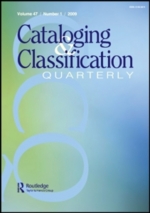
Semantic Interoperability between Bibliographic Conceptual Models
Introduction
Integration of library data into the semantic web (SW) demands a shift in conceptual data models and data format according to the SW principles and standards. New models have been developed for representing bibliographic information according to the new needs and formats. Well-known models are the Functional Requirements for Bibliographic Records (FRBR) and its consolidated version Library Reference Model (LRM), the FRBR Object-Oriented version (FRBRoo), the Resource Description and Access (RDA) which is based on the FRBR/LRM, and the Bibliographic Framework (BIBFRAME). There also exist cultural heritage models, such as the Europeana Data Model (EDM).
Semantic interoperability between bibliographic conceptual models is a prerequisite for seamless navigation into the bibliographic universe. Moreover, explicit representation of relationships between bibliographic entities may enable the navigability of bibliographic information even more. Taken into account that derivative relationships are common among the bibliographic universe, there is a focus on them in the framework of this project. This project seeks to contribute to semantic interoperability by:
- studying models' constructs to discover similarities and differences between the models.
- mappings in terms of core classes/entities, inherent relationships, and derivative relationships.
- assessing the mappings using a testbed.
Materials
Tools
Data
MARC/XML
One MARC XML file containing a collection of 235 bibliographic records from the National Library of Spain and the Library of Congress. This file contains records for the following bibliographic families:- Cien años de soledad, 14 records
- Преступление и наказание (Crime and Punishment), 24 records
- Don Quijote, 11 records
- Faust, 25 records
- ᾿Ιλιὰς (Iliad), 25 records
- Бра́тья Карама́зовы (Karamazov Brothers), 20 records
- Madame Bovary, 29 records
- Ὀδύσσεια (Odyssey), 19 records
- The Scarlet letter, 19 records
- Tom Sawyer, 31 records
- Wuthering Heights, 18 records
Gold datasets
Two Gold Datasets have been developed to assess the mappings. They have been uploaded in the Virtuoso RDF server and SPARQL queries can be submitted.| Gold Datasets | SPARQL queries & Visualizations |
| Gold RDA dataset (.rdf) | Gold RDA dataset: graph IRIs, prefixes, SPARQL queries |
| Gold BIBFRAME dataset (.rdf) | Gold BIBFRAME dataset: graph IRIs, prefixes, SPARQL queries |
Mappings

Volume 57, Issue 5, pp.278-308.
The mappings presented in this paper have been implemented using the XSLT language. The mappings involve core RDA classes, inherent relationships, and derivative relationships.
-
Mapping - Derivative relationships (Expression-Expression only)
- Test Mapping - Derivative relationships (Work-Work & Expression-Expression)
The Wuthering Heights family has been used as an example in the paper.

Preprint submitted in June 2020.
The mappings presented in this paper have been implemented using the Python and the XSLT languages. The mappings involve core BIBFRAME classes, inherent relationships, and derivative relationships.
-
Mapping - Derivative relationships
- Preprocessing and Mapping BIBFRAME to RDA
- Display mapping (RDF XML file)
- BF2RDA dataset: graph IRIs, prefixes, SPARQL queries
Papers
- Zapounidou, S., Sfakakis, M., & Papatheodorou, C. (2013). Highlights of library data models in the era of Linked Open Data. In: Garoufallou E., Greenberg J. (eds) Metadata and Semantics Research. MTSR 2013. Communications in Computer and Information Science, vol 390. Springer, Cham. doi:10.1007/978-3-319-03437-9_38 . (Open Access Postprint)
- Zapounidou S., Sfakakis M., & Papatheodorou C. (2014). Integrating library and cultural heritage data models: the BIBFRAME - EDM case. In: Proceedings of the 18th Panhellenic Conference on Informatics. PCI 2014. ACM. doi:10.1145/2645791.2645805. (Open Access Postprint)
- Zapounidou S., Sfakakis M., & Papatheodorou C. (2014). Library Data Integration: Towards BIBFRAME Mapping to EDM. In: Closs S., Studer R., Garoufallou E., Sicilia MA. (eds) Metadata and Semantics Research. MTSR 2014. Communications in Computer and Information Science, vol 478. Springer, Cham. doi:10.1007/978-3-319-13674-5_25. (Open Access Postprint)
- Zapounidou, S., Sfakakis, M., & Papatheodorou, C. (2017). Representing and integrating bibliographic information into the semantic web: A comparison of four conceptual models. Journal of Information Science, 43(4), 525-553. doi:10.1177/0165551516650410. (Open Access Postprint)
- Zapounidou S. (2017) Studying Conceptual Models for Publishing Library Data to the Semantic Web. In: Kamps J., Tsakonas G., Manolopoulos Y., Iliadis L., Karydis I. (eds) Research and Advanced Technology for Digital Libraries. TPDL 2017. Lecture Notes in Computer Science, vol 10450. Springer, Cham. doi:10.1007/978-3-319-67008-9_63. (Open Access Postprint)
- Zapounidou S., Sfakakis M., & Papatheodorou C. (2017). Preserving Bibliographic Relationships in Mappings from FRBR to BIBFRAME 2.0. In: Kamps J., Tsakonas G., Manolopoulos Y., Iliadis L., Karydis I. (eds) Research and Advanced Technology for Digital Libraries. TPDL 2017. Lecture Notes in Computer Science, vol 10450. Springer, Cham. doi:10.1007/978-3-319-67008-9_2. (Open Access Postprint)
- Zapounidou S., Sfakakis M., & Papatheodorou C. (2019). Assessing the Preservation of Derivative Relationships in Mappings from FRBR to BIBFRAME. In: Garoufallou E., Sartori F., Siatri R., Zervas M. (eds) Metadata and Semantic Research. MTSR 2018. Communications in Computer and Information Science, vol 846. Springer, Cham. doi:10.1007/978-3-030-14401-2_22.
- Zapounidou, S., Sfakakis, M., & Papatheodorou, C. (2019). Mapping Derivative Relationships from RDA to BIBFRAME 2. Cataloging & Classification Quarterly, 57(5), 278-308. doi:10.1080/01639374.2019.1650152.
Research Team
- Sofia Zapounidou, PhD candidate
- Michalis Sfakakis, Associate Professor
- Christos Papatheodorou, Professor